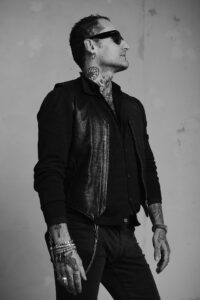As the founder and artistic director of Contemporary Cluster, you have created a space that celebrates interdisciplinarity and the contamination of different artistic forms. What was the initial vision that drove you to create this type of space and how has it evolved over time?
The original idea that gave life to Contemporary Cluster was to conceive a space where art could freely dialogue with other disciplines such as design, fashion, and music. My ambition was to transcend the conventional limits of art galleries by creating a dynamic environment where different expressive forms could interact and enrich each other. Over time, this vision has naturally evolved to embrace an even wider range of creative expressions. This expansion has been characterized by a particular emphasis on experimentation and research, placing at the center the value of contamination and interdisciplinary dialogue as a driver of innovation and cultural growth.
Now, after traversing multiple disciplinary territories, we propose to undertake a journey of greater introspection and depth. The goal is to establish a more intimate and profound dialogue with the artists of our gallery. This choice represents a return to a concept that we could define as ‘canonical’, where the interaction between artist and gallerist was based on a shared political commitment. Such interaction not only allowed for vital artistic exchange but also mutual growth fueled by intellectual and creative complicity. In our era, this relationship acquires renewed value, proposing itself as an antidote to contemporary fragmentations and superficialities.
You have worked as a lecturer and have been involved in various educational programs related to art. What is the importance of education and training in your work as a gallery owner and curator?
In my role as a gallerist and curator, education and training constitute the very essence of my commitment. My mission is to transmit and above all stimulate critical reflection and artistic conceptual inquiry. I want young artists to develop an authentic and unique vision, finding their own voice and artistic language. Navigating the complex landscape of contemporary art can be intimidating, but it is through education and support that they can find the courage and determination necessary to fully express themselves and contribute meaningfully to the visual culture of our time. I firmly believe that a solid educational foundation is crucial for artists as it allows them to contextualize their works within a broader historical and theoretical framework.
What drew you to your role as a gallerist and artistic director? What do you look for in your work?
My approach to the role of gallerist and artistic director was guided by a deep passion for contemporary art and the desire to explore new expressive territories. From the beginning of my career, I felt the urgency to support and promote innovative artists, those who not only reflect but also challenge and redefine existing cultural paradigms. I have always sought to push the boundaries of art, highlighting artistic practices that dialogue with the sociocultural context of their time.
In my work, I look for authenticity and audacity. I am drawn to artists who have a clear and personal vision, who are capable of transforming common materials into something meaningful. My search has always been oriented towards works that can stimulate critical reflection. I firmly believe in the role of art as a tool for knowledge and change, and my goal has always been to create a space where these dynamics can emerge. What I continue to seek in my work is the opportunity to support a form of creativity that is both radical and deeply connected with human reality.
From your perspective, what trends do you see emerging in contemporary art? Are there particular movements or themes that you believe will be prevalent in the coming years?
From a perspective attentive to the complexity of the contemporary panorama, it is clear that art is undergoing a phase of metamorphosis. The hybridization between disciplines that has characterized the last decade represents not just an aesthetic trend but a true revolution in artistic creation. The barriers between different forms of expression are dissolving, creating fertile ground for experiments that challenge conventions and invite new modes of perception and interaction.
In this context, there is an increasingly evident need for a return to the past. This is not merely a nostalgic revival but a conscious recovery of methodologies and sensibilities that prioritize the quality of the material and attention to detail. This return implies a renewed respect for the care with which the work is conceived and realized. The materiality of art—its tangible and sensory being—becomes the focus of an honest dialogue between the artist, the work, and the audience.
Simultaneously, the affirmation of one’s individuality becomes crucial. In an increasingly globalized and interconnected world, the artist must distinguish themselves, find a unique and authentic voice. This identity search is not an end in itself but represents the first step towards the construction of a shared collectivity. Only by recognizing and valuing one’s peculiarities is it possible to contribute to an artistic dialogue where individual voices intertwine in a heterogeneous chorus.
How do you define “success” for an artist in the context of contemporary art? Is there a balance between critical recognition, popularity, and artistic integrity that you consider ideal?
The concept of success for an artist in the realm of contemporary art is an issue of extraordinary complexity that transcends simple critical recognition or mere popularity. In my view, the essence of true success lies in an artist’s ability to remain steadfast to their vision, a process that requires a delicate balance between achieving critical recognition and popularity.
Critical recognition is essential as it affirms the quality and significance of the work, providing an intellectual and historical legitimization that can ensure its enduring presence. Popularity, on the other hand, is crucial for ensuring visibility and opportunities for growth, allowing the artist to reach a broader and more diversified audience. However, it is crucial that the artist preserves their creative integrity: they must pursue their inner research with dedication, resisting the allurements of market trends or external pressures that might divert them from their authentic expression.
Enduring success in contemporary art manifests when an artist manages to exert a profound and lasting influence, inspiring others with their work and leaving a unique and indelible mark. This imprint is not only visual or aesthetic but translates into a contribution to the cultural and intellectual discourse of their time. In this sense, the success of an artist is not a static achievement but a continuous process of growth and affirmation of one’s identity in constant dialogue with the historical and social context in which they operate.


